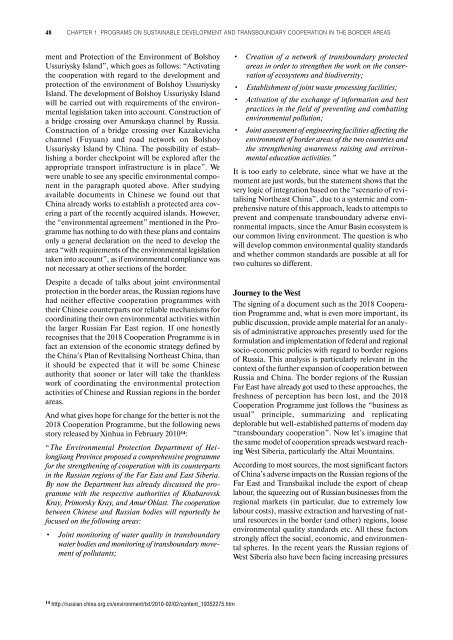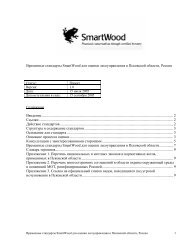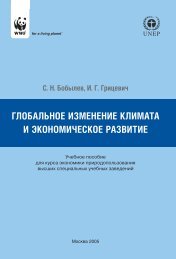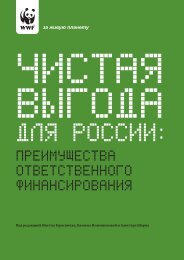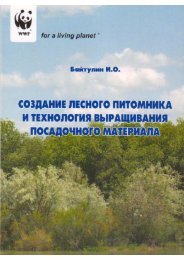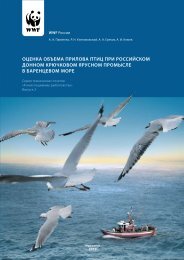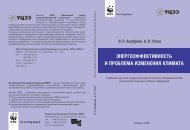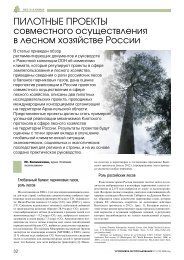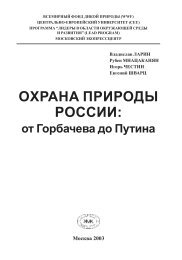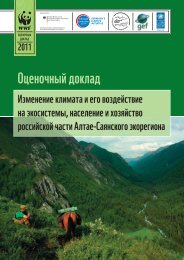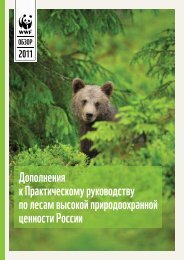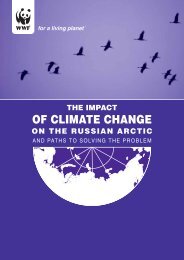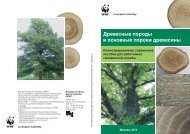to sino- russian
to sino- russian
to sino- russian
Create successful ePaper yourself
Turn your PDF publications into a flip-book with our unique Google optimized e-Paper software.
48 CHAPTER 1. PROGRAMS ON SUSTAINABLE DEVELOPMENT AND TRANSBOUNDARY COOPERATION IN THE BORDER AREAS<br />
ment and Protection of the Environment of Bolshoy<br />
Ussuriysky Island”, which goes as follows: “Activating<br />
the cooperation with regard <strong>to</strong> the development and<br />
protection of the environment of Bolshoy Ussuriysky<br />
Island. The development of Bolshoy Ussuriysky Island<br />
will be carried out with requirements of the environmental<br />
legislation taken in<strong>to</strong> account. Construction of<br />
a bridge crossing over Amurskaya channel by Russia.<br />
Construction of a bridge crossing over Kazakevicha<br />
channel (Fuyuan) and road network on Bolshoy<br />
Ussuriysky Island by China. The possibility of establishing<br />
a border checkpoint will be explored after the<br />
appropriate transport infrastructure is in place”. We<br />
were unable <strong>to</strong> see any specific environmental component<br />
in the paragraph quoted above. After studying<br />
available documents in Chinese we found out that<br />
China already works <strong>to</strong> establish a protected area covering<br />
a part of the recently acquired islands. However,<br />
the “environmental agreement” mentioned in the Programme<br />
has nothing <strong>to</strong> do with these plans and contains<br />
only a general declaration on the need <strong>to</strong> develop the<br />
area “with requirements of the environmental legislation<br />
taken in<strong>to</strong> account”, as if environmental compliance was<br />
not necessary at other sections of the border.<br />
Despite a decade of talks about joint environmental<br />
protection in the border areas, the Russian regions have<br />
had neither effective cooperation programmes with<br />
their Chinese counterparts nor reliable mechanisms for<br />
coordinating their own environmental activities within<br />
the larger Russian Far East region. If one honestly<br />
recognises that the 2018 Cooperation Programme is in<br />
fact an extension of the economic strategy defined by<br />
the China’s Plan of Revitalising Northeast China, than<br />
it should be expected that it will be some Chinese<br />
authority that sooner or later will take the thankless<br />
work of coordinating the environmental protection<br />
activities of Chinese and Russian regions in the border<br />
areas.<br />
And what gives hope for change for the better is not the<br />
2018 Cooperation Programme, but the following news<br />
s<strong>to</strong>ry released by Xinhua in February 201014 :<br />
“The Environmental Protection Department of Heilongjiang<br />
Province proposed a comprehensive programme<br />
for the strengthening of cooperation with its counterparts<br />
in the Russian regions of the Far East and East Siberia.<br />
By now the Department has already discussed the programme<br />
with the respective authorities of Khabarovsk<br />
Kray, Primorsky Kray, and Amur Oblast. The cooperation<br />
between Chinese and Russian bodies will reportedly be<br />
focused on the following areas:<br />
• Joint moni<strong>to</strong>ring of water quality in transboundary<br />
water bodies and moni<strong>to</strong>ring of transboundary movement<br />
of pollutants;<br />
14 http://<strong>russian</strong>.china.org.cn/environment/txt/2010-02/02/content_19352275.htm<br />
• Creation of a network of transboundary protected<br />
areas in order <strong>to</strong> strengthen the work on the conservation<br />
of ecosystems and biodiversity;<br />
• Establishment of joint waste processing facilities;<br />
• Activation of the exchange of information and best<br />
practices in the field of preventing and combatting<br />
environmental pollution;<br />
• Joint assessment of engineering facilities affecting the<br />
environment of border areas of the two countries and<br />
the strengthening awareness raising and environmental<br />
education activities.”<br />
It is <strong>to</strong>o early <strong>to</strong> celebrate, since what we have at the<br />
moment are just words, but the statement shows that the<br />
very logic of integration based on the “scenario of revitalising<br />
Northeast China”, due <strong>to</strong> a systemic and comprehensive<br />
nature of this approach, leads <strong>to</strong> attempts <strong>to</strong><br />
prevent and compensate transboundary adverse environmental<br />
impacts, since the Amur Basin ecosystem is<br />
our common living environment. The question is who<br />
will develop common environmental quality standards<br />
and whether common standards are possible at all for<br />
two cultures so different.<br />
Journey <strong>to</strong> the West<br />
The signing of a document such as the 2018 Cooperation<br />
Programme and, what is even more important, its<br />
public discussion, provide ample material for an analysis<br />
of administrative approaches presently used for the<br />
formulation and implementation of federal and regional<br />
socio-economic policies with regard <strong>to</strong> border regions<br />
of Russia. This analysis is particularly relevant in the<br />
context of the further expansion of cooperation between<br />
Russia and China. The border regions of the Russian<br />
Far East have already got used <strong>to</strong> these approaches, the<br />
freshness of perception has been lost, and the 2018<br />
Cooperation Programme just follows the “business as<br />
usual” principle, summarizing and replicating<br />
deplorable but well-established patterns of modern day<br />
“transboundary cooperation”. Now let’s imagine that<br />
the same model of cooperation spreads westward reaching<br />
West Siberia, particularly the Altai Mountains.<br />
According <strong>to</strong> most sources, the most significant fac<strong>to</strong>rs<br />
of China’s adverse impacts on the Russian regions of the<br />
Far East and Transbaikal include the export of cheap<br />
labour, the squeezing out of Russian businesses from the<br />
regional markets (in particular, due <strong>to</strong> extremely low<br />
labour costs), massive extraction and harvesting of natural<br />
resources in the border (and other) regions, loose<br />
environmental quality standards etc. All these fac<strong>to</strong>rs<br />
strongly affect the social, economic, and environmental<br />
spheres. In the recent years the Russian regions of<br />
West Siberia also have been facing increasing pressures


